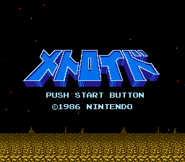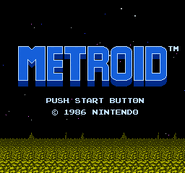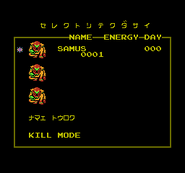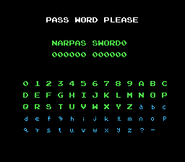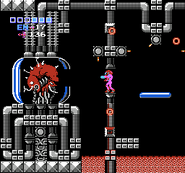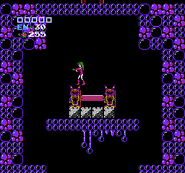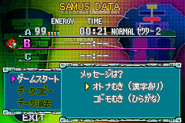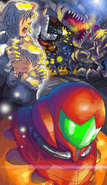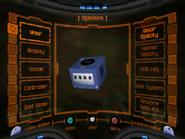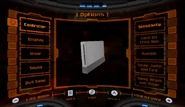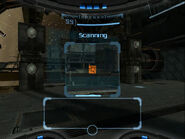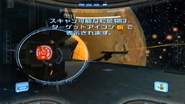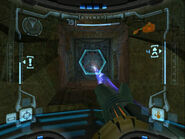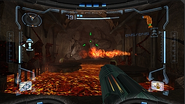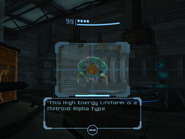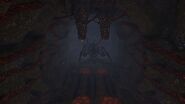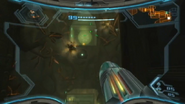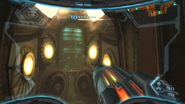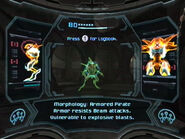| This article is written from the Real Life point of view |
This is a list of version differences in games of the Metroid series, including regional, cultural and revisional differences.
Metroid
FDS to NES
The original Metroid was first released on the Famicom Disk System in Japan in 1986, and on the NES a year later. Localization and hardware limitations meant that the NES and Famicom versions have several differences. The most notable difference between the two versions is the inclusion of battery-backed saving in the Famicom version. Hardware limitations with the NES version make saving impossible, necessitating a password system. All future Metroid games would include saving in all international versions.
- On the Title Screen, there is a space between the copyright symbol and year 1986.
- Also on the Title Screen, the color of the Zebesian surface is changed to a deeper green than is on the FDS version of the Title Screen.
- The letter O in the NES version includes a dot in the center, and the number 0 appears to be slashed. This is likely to distinguish between the two better.
- Music and sound in the FDS version are much richer, since it utilizes the system's wavetable sound channel.
- Title (Metroid), Samus Aran's Appearance Fanfare, Item Acquisition Fanfare, and Ending (Metroid) are the specific tracks that were simplified for the NES release.
- During a Game Over, the words "Game Over" are centered and white in the Famicom version, but higher in frame in the NES version, with reduced spacing as well. The color scheme changes depending on the area (for example, if Samus died in Brinstar it will be blue).
- The Samus Data Screen in the Famicom version includes counters measuring the number of times a file has been played and the amount of hours, or "days", played.
- The NES version includes a New Game + feature in which Samus retains all of her power-ups, but not Energy Tanks or Missile Tanks. If the better endings were scored, she will also be wearing her Justin Bailey suit. In the Famicom version, when restarting, the game simply restarts with no power-ups and armorless Samus is not playable.
- In the Famicom version, the Missile Counter digits have a blue drop shadow, which also appears on the timer during the countdown at the end of the game. This does not appear in the NES version.
- When fighting Mother Brain in the Famicom version, the entire lower half of the Control Capsule will shatter when struck with a Missile; in the NES version, only a small hole will appear in it, through which Samus can attack Mother Brain.
- The ending text is yellow in the English version, and blue in the Famicom version. The line "In the space" from the Famicom version is changed to "In space" in the NES version, but the text is overall still poorly translated.
- The credits in the FDS version are blue, and cyan in the NES version, which also changes "Main Programmed By" to "Main Programmers" and "Chief Directed By" to "Chief Director". The credit "Tohryu Mako Benkei" is removed and replaced with "Converted by T . Narihiro". When the credits end, the words "The End" appear. In the FDS version, "Push Start Button" appears underneath, which it does not in the NES version.
- The directional patterns of attacks from Squeepts, Sidehoppers and Dessgeegas, Polyps, Dragons, Kraid and Ridley vary between versions. They have set patterns in the NES version, but varying patterns in the FDS version. For example, Polyp projectiles are fired erratically and randomly to both the left and right in the FDS version, but only one of the two in the NES version.
- The FDS version has shorter loading times when moving between the areas of Zebes. When starting or saving the game and right before the ending, the disk must be flipped.
- The FDS version has much less lag than the NES version, most notably during boss battles and in Tourian.
- The Escape theme in the NES version includes an uplifting verse, which the FDS version does not.
- Samus can rapidly fire in the NES version when the B button is held.
- The time requirement for the best ending is two hours in the FDS version, and one hour in the NES version.
Nintendo GameCube
Metroid is available on the Nintendo GameCube as a feature in Metroid Prime, unlocked by using a Nintendo GameCube Game Boy Advance Cable to link with a copy of Metroid Fusion containing a completed save file, which is identified with a Metroid to the right of the area in which the file was last saved.
- The color of the Zebesian surface is changed from green to orange. This carried over to the Game Boy Advance re-releases of Metroid.
- Several sounds, such as firing a Missile or using the Screw Attack, are fainter, likely to prevent speakers overloading.
- It is now possible to save passwords generated when Samus dies. This carried over to the Game Boy Advance re-releases of Metroid.
Game Boy Advance
Metroid is available on the Game Boy Advance as part of the Classic NES Series/Famicom Mini series of re-releases, and as an unlockable in Metroid: Zero Mission.
- The logo and text have also been compressed, and in Zero Mission, the year is changed from 1986 to 1986-2004, the year Zero Mission was released. Furthermore, "Push Start Button" has been repaired to simply "Press Start"
- All instances of "pass word" are changed to "password".
- The sound made when pausing the game plays rather shrilly compared to previous versions.
Gallery
Metroid II: Return of Samus
Nintendo 3DS Virtual Console
- Like all other 3DS Virtual Console games, players may touch the touch screen to access the Virtual Console menu, which allows them to resume the game, create a restore point, load a restore point, or reset the game.
- Like all other Game Boy games on the 3DS Virtual Console, pressing Y while holding the L and R shoulder buttons will swap the game's color palette from black and white to black and green, emulating the appearance of the original Game Boy.
- The periodic rapid blinking on the Title Screen has been reduced from four (in the original Game Boy game) to three (in the Virtual Console version).
Metroid Fusion
- The European version changes "Press Start" on the Title Screen to "Start Game", and adds a Language option. The Screw Attack in the Japanese version has a duller color scheme than that of North America and Europe, and replaces the ™ with an ®.
- The North American version does not have a customizable difficulty setting, with it locked to Normal Mode, while the Japanese version includes an Easy and Hard Mode.
- The Japanese and Chinese versions include an Adult Mode and Child Mode, which changes the text to kanji or hiragana. This also affects which endings are displayed. Child Mode's endings depict events from Samus's past, and Adult Mode's endings depict Samus in a revealing outfit. The Child Mode endings are inaccessible in Western versions of the game, but can be unlocked by connecting the game to Zero Mission.
- The player must always adjust their sound settings on the Samus Data Screen in the North American version as the game will not remember them. In the Japanese version, it will.
- A Gallery of unlocked ending images becomes available in the Japanese version after completing the game, and can be accessed on the Title Screen.
- In subsequent playthroughs of the Japanese version, the introduction cutscene can be skipped.
Gallery
Metroid Prime
There are many differences between the NTSC and later-released PAL versions of the game, with the most notable being a complete alteration of the Pirate Data. The PAL changes would be retained in the Wii versions of the game in all regions, effectively retconning the NTSC changes.
NTSC to PAL
- The gate at the top of the Arboretum has a small gap at the top of it which can be traversed via the Morph Ball, but in the PAL, Players' Choice, and NTSC 0-01 versions, there is an invisible wall in its place.
- In PAL and all other game versions except NTSC 0-00, scan dashing is impossible.
- In the PAL version, the introduction[1] and ending[2] cutscenes both feature a male narrator. The narrator also announces two area names when moving to and from the Tallon Overworld and the Impact Crater. All narration was removed in all Wii versions.
- In the PAL version, if Samus defeats the Phazon Elite and leaves the room, the Artifact of Warrior does not disappear. In the NTSC Player's Choice version, the doors will remain locked until the Artifact is collected.
- In the PAL version, Baby Sheegoths have more energy.
- After the battle with the Cloaked Drone in the Central Dynamo, the door behind the rubble locks until Samus gets the Power Bomb upgrade in every version of the game except the original NTSC version.
- The PAL version's credits are slightly different, where during the credits, holding down the analog stick does not make the credits go faster. In the Japanese version, the Japanese staff will be listed first. European staff credits are only present in original PAL versions of the game.
- The PAL version has a different, more intense Grapple Beam cutscene than the NTSC version, in which Samus poses the same way as she does after collecting a Chozo Artifact.
- The NTSC version only has one type of Missile Ammo that gives Samus five missiles while the PAL version has 3 different types, that restore 3, 5 and 10 Missiles.
- The PAL and NTSC versions have different Phazon Suit cutscenes.
- In the NTSC version, the Subchamber 3 and Subchamber 4 have the same tunnel grooves while the PAL version has different ones, Subchamber 3 has 2 grooves and Subchamber 4 has 1 groove.
- In the PAL version, the Missile Counter shows the amount of missiles Samus is capable of carrying (right number) and the amount she is carrying (left number), in the NTSC version, it only shows the amount of missiles Samus is carrying.
- The PAL version has an animation for the Title Screen symbol (the Screw Attack symbol).
- The Hunter Metroid in the Frost Cave is missing in the PAL version, but returns in Trilogy.
- In the PAL version, the Pause Screen main menu has a counter to show how much percentage Samus has collected of Items and Scans.
- In the PAL version, some speedrunning techniques were disabled in an attempt to discourage it, such as the inability to lock onto the glowing spidervine in Tallon Overworld to obtain the Space Jump Boots early.
- Save files in the NTSC version uses 1 save block, while the PAL version uses 3.
- Samus's suit gives more warnings in the PAL versions, such as "Data Received", when the hint system comes on and "Warning, poison gas detected" when she first enters the Ventilation Shaft.
- In the PAL version, when Samus loses her abilities aboard the Frigate Orpheon, a voice will dictate the names of the abilities she loses, saying "Varia Suit [or other item] malfunction."
- The warning noise produced by the Threat Assessment when in close proximity to hazardous things differs in the NTSC and PAL versions.
- The door to the Phazon Processing Center after the Omega Pirate takes longer to open in the PAL version, to prevent crashing that occurs in the NTSC version.
- In the PAL version, after defeating the Omega Pirate, Fission Metroids will begin to appear in the Phazon Mines. Fission Metroids only appear in the Impact Crater in the NTSC version.
- In the Ruined Shrine, there is a root that can help Sequence Break, but it is removed in the PAL version. This makes it harder to get into the room above without the Boost Ball.
- In the PAL version, it is possible to obtain the Missile Launcher upgrade prior to the battle with the Hive Mecha, due to the size of the battle trigger point being considerably smaller in the PAL version.
- In the PAL version, it is not possible to shoot the Power Conduit in the Ruined Courtyard without the Thermal Visor because it does not appear until Samus acquires it.
- The scan point for the Hive Mecha is below the toxic water in the NTSC version.
- In the Main Quarry, the Door at the top of the room is locked until Samus gets the Power Bomb in the PAL version.
- The Ice Shriekbats do not disappear in the Ice Ruins West in the PAL version.
- The Pirate Data and Chozo Lore are different in the PAL version. The Pirate Data specifically states that they never made any official contact with the Metroid Prime.
- The Metroid: Alpha Type is identified as a regular Tallon Metroid in the PAL version.
- The Flaaghra battle theme loops correctly in the PAL version.
- The map displays a compass point in the PAL version.
- The doors to Plasma Processing and Storage Depot B, where the Plasma Beam and Grapple Beam are kept, are covered with Bendezium, requiring a Power Bomb to get by in the PAL version. This is to prevent them from being obtained early via Ghetto Jumps.
- Power Bombs can be used to destroy the Omega Pirate's Phazon Armor in the PAL version.
- During his boss fight, Meta Ridley performs ground-stomping attacks in the PAL version.
- In the PAL version, when Metroid Prime uses its Snare Beam on Samus, it will close its face, preventing harm to it. Also, when he charges across the room, she does not bounce out of the grooves.
- The engine flare of Samus's ship as it enters space is improved in the PAL version.
- A full image of Samus with or without her helmet depending on ending will appear on the Mission Final screen in the PAL version.
Nintendo GameCube to Wii
There are some differences between the original version of the game, and its re-releases on the Wii as part of New Play Control! Metroid Prime and Metroid Prime Trilogy.
- The game has a control scheme similar to that of Metroid Prime 3: Corruption. The Spring Ball is also included and can be used by flicking the Wii Remote up, but only once the Morph Ball Bomb ability has been regained.
- Due to the availability of the Spring Ball, some Morph Ball platforming passages become easier (or even safer) to navigate than in the GameCube version. For example, the Transport Tunnel A in Magmoor Caverns contain some blocks in the lava in front of a ledge that would give way and cause Samus to fall (and scorch herself) after they are hit with two Morph Ball bombs, which would punish those who did not properly use the Morph Ball bombs to jump in the GameCube version. This can be easily bypassed with the Spring Ball in the Wii version.
- The game supports 16:9 widescreen.
- The file selection screen in the New Play Control! version is redesigned so that its user interface resembles that of Corruption. It is now possible to copy files from one slot to another, which could not be done in the GameCube version.
- There are three difficulty levels, Normal, Veteran and Hypermode. The Normal difficulty is a new, easier difficulty, while Veteran reproduces the Normal difficulty in the original GameCube release, and Hypermode reproduces the Hard difficulty in the original GameCube release, which is only available after finishing the game once on either Normal or Veteran difficulty.
- Some boss battles are significantly more difficult, especially when Lock On/Free Aim is enabled by default. For example, the Hive Mecha boss fight can be difficult with the Free Aim feature, as the player may often not have enough time to properly orient the pointer and turn around to get a fix on its weak point. This same feature makes it difficult to land ranged shots on the Omega Pirate's Phazon Armor, or hit Meta Ridley's mouth in the second phase when his health is low.
- Bonus material is unlocked by collecting and spending Credits throughout the game.
- The Screen-Shot Tool from Corruption can be unlocked and used.
- The Fusion Suit is now unlocked with the Bonus Credit system after finishing the game, and costs one Orange Credit and two Silver Credits to unlock.
- Metroid is no longer unlockable as a bonus, due to its availability on Virtual Console.
- The Charge Meter that fills up as the Charge Beam is being charged is removed.
- During the Orpheon's self-destruct sequence, the tutorial prompt for the Grapple Beam that should show up in Biotech Research Area 2 is missing, due to an apparent bug.
- The Chozo Lore, though based on the PAL version, is slightly altered. Notably, the Chozo describe the Phazon corrupting the planet at a much quicker pace, which is more consistent with the rapid effects seen in Metroid Prime 3: Corruption. The 12 Chozo Artifacts are also mentioned more prominently.
- The Sight Window is more reminiscent of Corruption.
- When starting from a previous save, Logbook scans will be retained.
- When a scan is recorded in the Logbook, the words "Recorded to Logbook", from Prime's sequel can be heard.
- The suit doesn't speak as often in the North American version, as it will only say, "Data Received" and "Recorded to Logbook". Also, the suit will say "Heat level critical" if Samus enters superheated rooms in the Magmoor Caverns without the Varia Suit and likewise loses energy from the high temperature.
- During the boss fight against Hive Mecha, the doors will lock, even as the acid water rises, to fully prevent players from trying to escape the Hive Totem until the battle is finished.
- Bloom-lighting has been added throughout the game (most noticeably during the Thardus battle)
- Textures and shadows are sharper and clearer.
- Particle effects on the Charge Beam, such as frost forming on the Ice Beam, and water ripple effects were removed. This was a drastic design decision that was made, possibly due to the constraints of the Wii dual-layer disc and an arm cannon that was no longer static.
- Doors open much faster, with no likelihood of crashing.
- The Scatter Bombu in the Research Access no longer have electrical sparks coursing over them.
- Ice Troopers can no longer be shattered with a Missile after being frozen with the Ice Beam.
- Pirate Troopers and Fission Metroids are especially a little more difficult to defeat in this version, as they can only be defeated by a different beam, and beam-switching in this version requires the player to hold down a button and point to the correct Beam icon before being able to attack a certain kind of Pirate Trooper or Fission Metroid, which is slower than flicking the C Stick to change Beams in the GameCube version.
- The spinning GameCube in the options menu is changed to a Wii.
- The names of the Beams will not show up on the Map screen legend until the beam is acquired.
Gallery
Metroid: Zero Mission
- The Japanese version include Adult Mode and Child Mode, which change the text to kanji or hiragana.
- In the European version of the game, two missile blocks in the Space Pirate Mother Ship are changed. Instead of coming back after being destroyed and leaving the room they were in, they stay destroyed and don't come back.
Gallery
Metroid Zero Mission JP language modes.png|Adult and Child Modes (Japan)
Metroid Prime 2: Echoes
Nintendo GameCube to Wii
Much like Metroid Prime, there are some differences between the original version of the game, and its re-releases on the Wii as part of New Play Control! Metroid Prime 2: Dark Echoes and Metroid Prime Trilogy.
- The game has a control scheme similar to that of Metroid Prime 3: Corruption. The Spring Ball is also included and can be used by flicking the Wii Remote up, but only once the Morph Ball Bomb ability has been regained.
- This has the side effect of making the Spider Guardian easier to fight, since the player no longer has to rely on Bomb Jumping.
- The game supports 16:9 widescreen.
- The file selection screen in the New Play Control! version is redesigned so that its user interface resembles that of Corruption. It is now possible to copy files from one slot to another, which could not be done in the GameCube version. The Demo video has been changed too.
- There are three difficulty levels, Normal, Veteran and Hypermode. The Normal difficulty is a new, easier difficulty, while Veteran reproduces the Normal difficulty in the original GameCube release, and Hypermode reproduces the Hard difficulty in the original GameCube release, which is only available after finishing the game once on either Normal or Veteran difficulty.
- Bonus material is unlocked by collecting and spending Credits throughout the game.
- The Screen-Shot Tool from Corruption can be unlocked and used.
- The Charge Meter that fills up as the Charge Beam is being charged is removed.
- The Sight Window is more reminiscent of Corruption.
- When starting from a previous save, Logbook scans will be retained.
- Bloom-lighting has been added throughout the game.
- Textures and shadows are sharper and clearer.
- Doors open much faster, with no likelihood of crashing.
- The names of the Beams will not show up on the Map screen legend until the beam is acquired.
- The four lights on top of Samus's HUD indicates the Wii Remote´s battery life.
- When the Wii Remote aims at the edge of the screen, the HUD withdraws and shows a white circuitry pattern like the one in Corruption.
- Unlike Corruption, if Samus aims at the center of the screen and keeps the Wii Remote still, she will put her hand on the Arm Cannon.
- Some Luminoth Lore locations have been changed.
- The music played when acquiring the Energy Transfer Module or a Dark Temple Key has been changed.
- When the Ingsmashers in the Hall of Combat Mastery awaken, the doors will lock until they are defeated.
- A message will appear when picking up Samus's first Power Bomb refill.
- When entering a Phazon-rich area inhabited by Dark Tallon Metroids, the Impact Crater theme from Metroid Prime will play.
- The theme played during an Energy Controller restoration cutscene has been extended instead of simply looping.
- Certain boss battles, most notably the Boost Guardian, are easier to complete on Normal. On the other side, some bosses deal more damage on Veteran and Hard.
- The theme for the Dark Troopers has been altered, and now plays every time they show up.
- Worker Splinters will still appear in the GFMC Compound upon revisits, scavenging the trooper corpses. Additionally, the bodies of defeated Dark Troopers in this room would remain in the Gamecube original; this is no longer the case in the Trilogy re-release.
Metroid Prime 3: Corruption
As with Prime, most changes have been made to the PAL and Trilogy versions. In addition, the Japanese version features two notable differences: a questionnaire at the beginning determines the game's difficulty level, and during the Norion countdown, "Meteor impact in [# of minutes, up to 4] minutes" will flash onscreen in red text for every minute that passes. This is because no dubbing was done for the Japanese version; the English voicing is still retained.
NTSC to PAL
- During the Ready Room cutscene, Admiral Dane says "No!" when he realizes that the Space Pirates are targeting the defense system on Norion, as opposed to "Damn!" in the NTSC version.
- Munitions Storage is renamed Data Storage A, and Data Storage is renamed Data Storage B.
- On the first visit to Botanica in Eastern SkyTown, the room is full of Sky Puffers. "Dragoon" Battle Drones appear on further visits.
- Leviathan Seeds can be seen exploding when leaving them.
- The rotating gate obstruction in the Piston Hall room in SkyTown East has been removed; Sky Puffers now inhabit the area.
- Bosses have their own sub-category in the creatures section of the Logbook.
- The green-colored turrets on the Pirate Homeworld are given the name Despair-Class Turret and have their own Logbook entry.
Original to Trilogy
- The Bryyo Cliffside theme has been extended.
- The Boss Reptilian theme has been modified to include the clacking and clanking beat heard in the Boss Reptilian2 theme.
- The first few seconds of the Space Pirate battle theme played when fighting them at the Temple of Bryyo are louder.
- The Metroid Battle Theme and Bryyo Thorn Jungle themes have been removed from the Soundtrack Gallery, and replaced with the Berserker Lord and Aurora Unit 313 themes.
- The "Armored Pirate" in Concourse no longer has a separate Logbook entry or grants an extraneous Red Credit.
- Three of the Galactic Federation Data locations were changed.
- The inactive terminal in Data Storage B on Norion can now be scanned, providing the codes to hear the secret messages on the Transmission Console in Samus's Gunship.
- The Piston Hall in Eastern SkyTown no longer has Sky Puffers or a rotary hatch, and now has an alternating Force Field blocking the north side of the room.
- The final scene in the SkyTown migration cutscene has been changed to a lower, wider shot of the facility moving towards the Leviathan Seed (it was originally a top-down distant view).
- When Dark Samus is defeated, the sound heard when receiving her Gold Credit is now the same as when other bosses are killed; before, it was the same sound when receiving a Friend Voucher.
Gallery
Metroid: Other M
- The English version of Other M allows the player to select French or Spanish subtitles, but the Japanese voice dub is not accessible. The voices and subtitles can be changed between English and Japanese in the Japanese version. It is likely that Japanese voices cannot be selected in the American version because of licensing issues with the voice actors. In the European version, French, Spanish, German and Italian subtitles can be selected.

